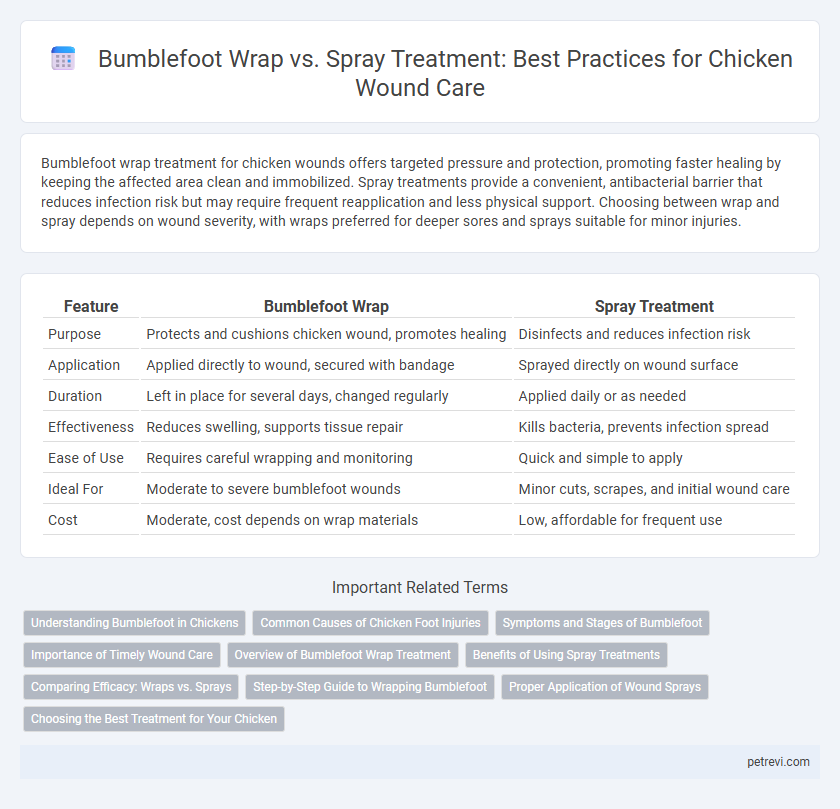Bumblefoot wrap treatment for chicken wounds offers targeted pressure and protection, promoting faster healing by keeping the affected area clean and immobilized. Spray treatments provide a convenient, antibacterial barrier that reduces infection risk but may require frequent reapplication and less physical support. Choosing between wrap and spray depends on wound severity, with wraps preferred for deeper sores and sprays suitable for minor injuries.
Table of Comparison
| Feature | Bumblefoot Wrap | Spray Treatment |
|---|---|---|
| Purpose | Protects and cushions chicken wound, promotes healing | Disinfects and reduces infection risk |
| Application | Applied directly to wound, secured with bandage | Sprayed directly on wound surface |
| Duration | Left in place for several days, changed regularly | Applied daily or as needed |
| Effectiveness | Reduces swelling, supports tissue repair | Kills bacteria, prevents infection spread |
| Ease of Use | Requires careful wrapping and monitoring | Quick and simple to apply |
| Ideal For | Moderate to severe bumblefoot wounds | Minor cuts, scrapes, and initial wound care |
| Cost | Moderate, cost depends on wrap materials | Low, affordable for frequent use |
Understanding Bumblefoot in Chickens
Bumblefoot in chickens is a bacterial infection causing swelling and abscesses on the footpad, often triggered by cuts or pressure sores. Wrap treatments provide targeted compression and protection, promoting healing by reducing swelling and keeping contaminants out. Spray treatments offer antibacterial action and ease of application but may lack the protective support necessary for deeper or more severe wounds.
Common Causes of Chicken Foot Injuries
Bumblefoot in chickens often results from foot injuries caused by rough or wet coop flooring, sharp objects, or constant pressure on the feet. Wrap treatment provides better protection by immobilizing the wound and preventing dirt entry, while spray treatment offers ease of application but may not adequately shield against contaminants. Both methods require cleanliness and regular monitoring to prevent infection and promote efficient healing.
Symptoms and Stages of Bumblefoot
Bumblefoot in chickens presents as swelling, redness, and a dark scab on the footpad, often progressing through stages from mild inflammation to deep abscess formation. Wrap treatments promote healing by applying direct pressure and keeping the wound clean, reducing swelling and preventing contamination during the inflammatory and early abscess stages. Spray treatments are more effective for superficial irritations or minor wounds but may not penetrate deep infections typical of advanced bumblefoot stages.
Importance of Timely Wound Care
Timely wound care in chickens significantly reduces the risk of infection and promotes faster healing, with Bumblefoot Wraps providing targeted protection and pressure relief for foot lesions. Spray treatments offer quick application and antiseptic benefits but may lack the sustained compression necessary to prevent swelling and further injury. Choosing an appropriate method early ensures effective bacterial control and minimizes long-term damage to poultry health.
Overview of Bumblefoot Wrap Treatment
Bumblefoot wrap treatment for chicken wounds involves applying a medicated dressing directly to the infected footpad to reduce swelling and promote healing. The wrap typically includes an antibiotic ointment or antiseptic, covered by gauze and secured with adhesive tape or vet wrap to maintain cleanliness and prevent further injury. This method provides targeted care, encourages drainage of abscesses, and supports faster recovery compared to spray treatments alone.
Benefits of Using Spray Treatments
Spray treatments for chicken wound care offer quick application and even coverage, reducing the risk of contamination and stress for the bird. These sprays often contain antimicrobial agents that promote faster healing by preventing bacterial infections commonly associated with bumblefoot. Using spray treatments ensures a less invasive approach, allowing for easier reapplication and improved accessibility to hard-to-reach wounds.
Comparing Efficacy: Wraps vs. Sprays
Bumblefoot wrap treatments provide sustained pressure and protection, promoting faster healing by preventing contamination and reducing swelling in chicken wounds. Spray treatments offer ease of application and immediate antiseptic action but may require frequent reapplication, potentially leading to slower recovery rates. Studies indicate that wraps generally outperform sprays in efficacy due to their ability to maintain a controlled healing environment and shield the affected area from further injury.
Step-by-Step Guide to Wrapping Bumblefoot
Cleaning the wound thoroughly with antiseptic solution is the first step when treating bumblefoot in chickens. Next, apply an antibiotic ointment directly onto the abscess before carefully wrapping the foot with gauze and securing it with vet wrap to protect against dirt and moisture. Change the wrap every 24 to 48 hours, monitoring for signs of infection or healing progress to ensure effective wound care.
Proper Application of Wound Sprays
Proper application of wound sprays for chicken Bumblefoot involves thoroughly cleaning the affected area before treatment to ensure maximum absorption and effectiveness. Use a spray solution that contains antiseptic and antibacterial agents, applying it directly to the wound while avoiding excessive moisture that could hinder healing. Regular reapplication as per product instructions promotes faster recovery by preventing infection and reducing inflammation.
Choosing the Best Treatment for Your Chicken
Bumblefoot wrap treatment provides consistent pressure and protection, reducing infection risk by keeping the wound clean and immobilized, which is ideal for severe or deep abscesses. Spray treatments offer quick application and are less stressful for chickens, making them suitable for minor wounds or early-stage infections, but may require more frequent reapplication to maintain effectiveness. Evaluating the wound severity, chicken behavior, and ease of application helps determine whether a wrap or spray offers the best healing environment for your flock.
Bumblefoot Wrap vs Spray Treatment for Chicken Wound Care Infographic

 petrevi.com
petrevi.com